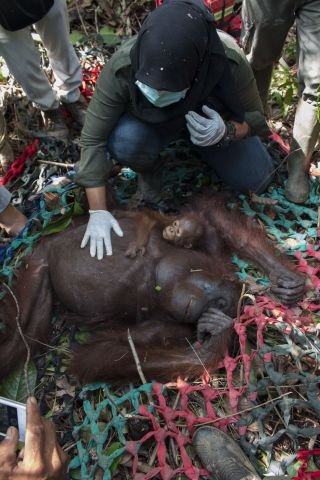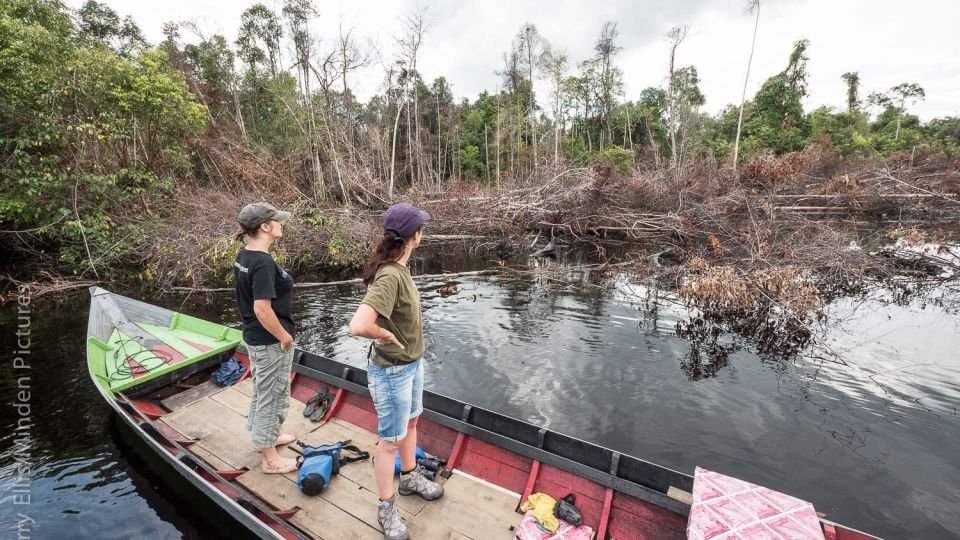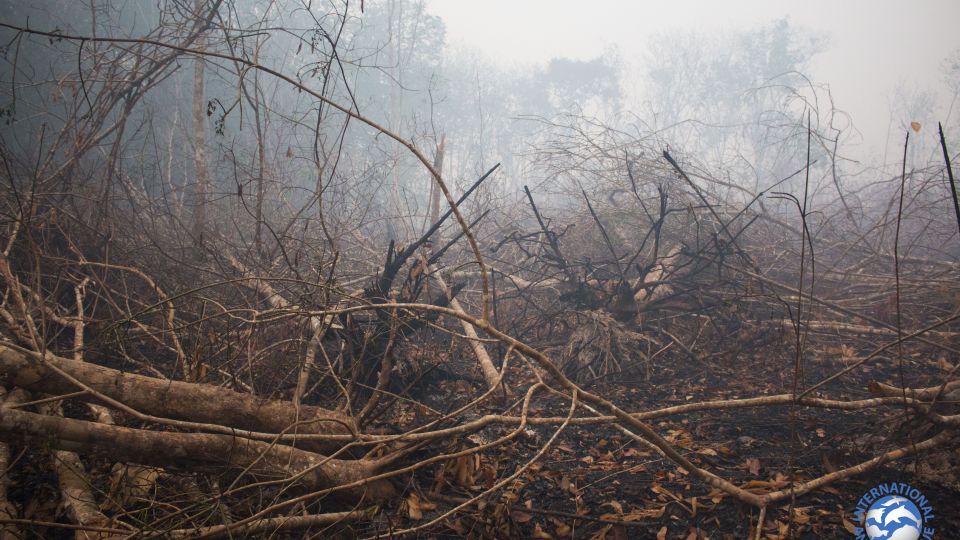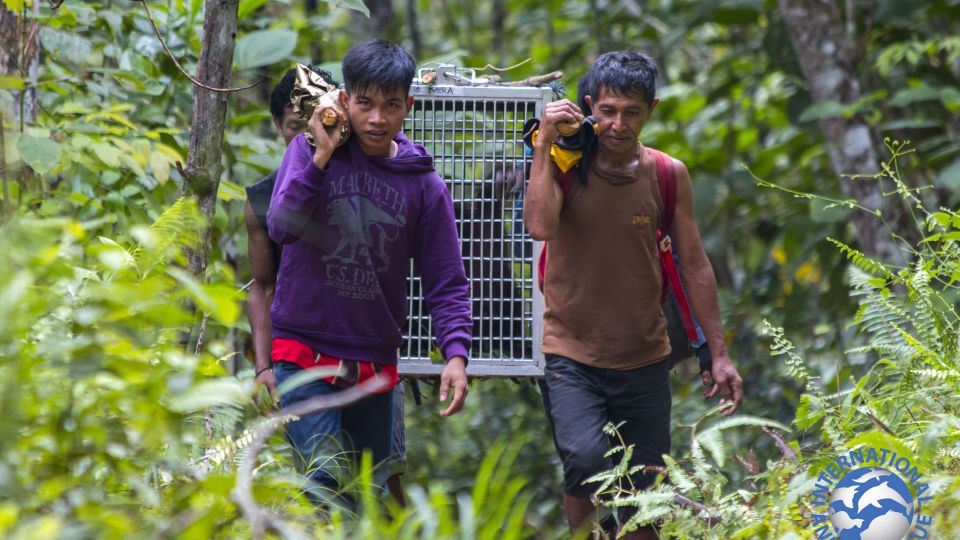
According to Indonesia’s National Space and Aviation Agency (LAPAN), more than 2 million hectares of land have been burnt in the past few months alone, and it is still not known what devastating and perhaps irreparable damage these recent fires have had on Indonesia’s tropical rainforests and already rapidly declining orangutan populations.
The damage caused by these fires can be seen in many places across Kalimantan, particularly in Ketapang, West Kalimantan. One such area is the Community Forest of Pematang Gadung, a 21,000 hectare peat swamp forest which contains a very rich and unique biodiversity, and a dense population of orangutans. IAR Indonesia has been working to protect this unique biodiversity and has witnessed the devastating degradation of this critical habitat.
“There are no words to express how we feel about this. All our efforts to protect orangutans and their habitat are in vain when fires destroy everything in an instant,” says Karmele Llano Sanchez, Programme Director of IAR Indonesia. “But we are determined to save this forest, its unique biodiversity and this important peat swamp ecosystem.” IAR Indonesia has been working in the area for the last three years establishing an eco-tourism project in this community forest and working with communities to reduce carbon emissions and find sustainable sources of income.

In the last few months, the team from IAR Indonesia has been working round the clock trying to save orangutans from burnt forests. “Thus far our Rescue Team has rescued more than 20 orangutans from burnt forest and we are still rescuing more. What is worse is that we don’t know how many orangutans might have perished before we were able to rescue them. This is by far the largest number of rescues IAR has had to conduct in the area since we opened our orangutan centre in 2009, and it is a terrible and deeply worrying indication of the plight of orangutans in Indonesia,” says Tantyo Bangun, Chairman of IAR Indonesia.
IAR’s Human Orangutan Conflict (HOC) team is monitoring orangutans in burnt areas. The animals are suffering from long time starvation and malnutrition because the fires have destroyed everything around them, leaving a landscape with few trees and no food sources. The HOC team tracks down, captures and translocates orangutans that stand no chance of survival without human intervention and is assisted by local people who raise the alarm when an orangutan is spotted in the area and in need of help.

“The saddest image you can think of is a magnificent orangutan that should be travelling in the top of the canopy but instead has to drag itself on the ground, struggling even to find a standing tree suitable to make a nest,” says Gail Campbell-Smith, Programme Manager of IAR Indonesia. “An extra concern is that, as habitat is wiped out, instances of human orangutan conflict increase and these orangutans are in danger of being killed by farmers as they enter farms looking for food.”
While IAR’s team works round the clock to save these animals and their forest, COP21, the United Nations Climate Change Conference, gets underway in Paris today, 30 November. Governments from all around the world are gathering to discuss an agreement to reduce carbon emissions and slow down the effects of climate change.
The fires that have spread out of control in Indonesia this year have been exacerbated by the extended dry season, caused by the El Nino Southern Oscillation (ENSO) phenomenon. These forest fires are responsible for massive carbon emissions, severely aggravating the effects of climate change, and have a devastating effect on human health. Similar fires in 1997 emitted between 0.81 and 2.57 gig tonnes of carbon (Page et al, 2002) and resulted in an estimated 20 million people suffering respiratory problems, with 19,800 – 48,100 premature deaths (Harrison et al, 2009).
The Indonesian Institute for Meteorology, Climatology and Geophysics (BMKG) has predicted another severe drought for next year, as the effects of this year’s El Nino continue in to the spring of 2016. While the belated monsoon has given a break to the forest fires, the risk that this will happen again next year is of profound concern. “If preventive measures are not taken, funds are not invested in fire prevention, and those companies and individuals who start the fires are not prosecuted, this ecological disaster (already called one of the worst ecological disasters of the century) could return again next year,” says Bangun.
Sanchez adds: “We are still dealing with the devastating effects of the previous fires and our team is working really hard to save the lives of as many orangutans as possible. Now we also need to start trying to restore and reforest the burnt areas. The thought of the humans and animals of Borneo and Sumatra experiencing it all again next year is too much to bear.”
The graphic photos and footage released by IAR show the devastating effects of the fires on the orang-utans. The images convey the helplessness of animals left stranded in the debris of forests burnt to the ground by the fires. Most poignant among those rescued are mothers with their tiny babies clinging to them. Only weeks ago the heartbreaking photo of Mama Anti and her baby shocked and moved people across the globe. The images of Mama Novia and baby Noval (main picture), who were among the latest series of rescues, are equally heart breaking. “This is not very different to the devastating effects of a war and it should be considered a world crime,” says Sanchez.

Last week the IAR team was able to celebrate the release of six of the rescued orang-utans in Gunung Palung National Park in West Kalimantan. This release operation involved 15 members of IAR’s team and 25 local people carrying the transport cages on foot to the release site – a trek that lasted four hours – and has been one of the few happy moments in the last few months. “We are glad these orangutans have been given a second chance. There is no doubt that all of them would now be dead if it was not for us,” says Campbell-Smith. The National Park authority, The Agency of Natural Resources Conservation (BKSDA) of Gunung Palung, granted permission to IAR to conduct these releases in the National Park.
Sanchez adds: “We are ready to continue working flat out to save the lives of animals that stand no chance of survival without our help. But that is not a lasting solution to the problem. It is vital that serious action is taken to prevent further outbreaks of fires. There is no future for the orangutan unless all parties involved can make a commitment to conserving sufficient habitat to ensure their survival and implement measures to reduce carbon emissions and reduce the likelihood of further El Nino climatic events. We hope that determined actions will result from this Climate Conference because we are running out of time.”
References:
Harrison, M. E., Page, S.E. & Limin, S.H. (2009). The global impact of Indonesian forest fires. Biologist, Vol. 56, pp. 156-163.
Page, S.E., Siegert, F., Rieley, J.O., V. Boehm, H.D., Jaya. A. & Limin. S. (2002). The amount of carbon released from peat and forest fires in Indonesia during 1997. Nature, Vol. 420, pp. 61-65.

